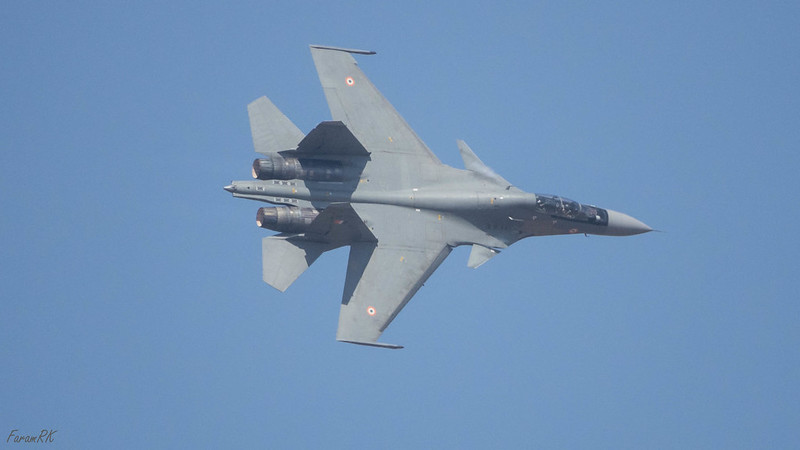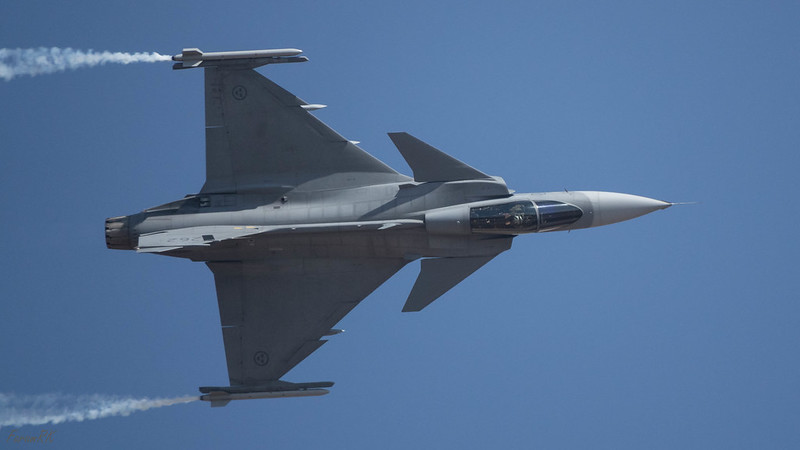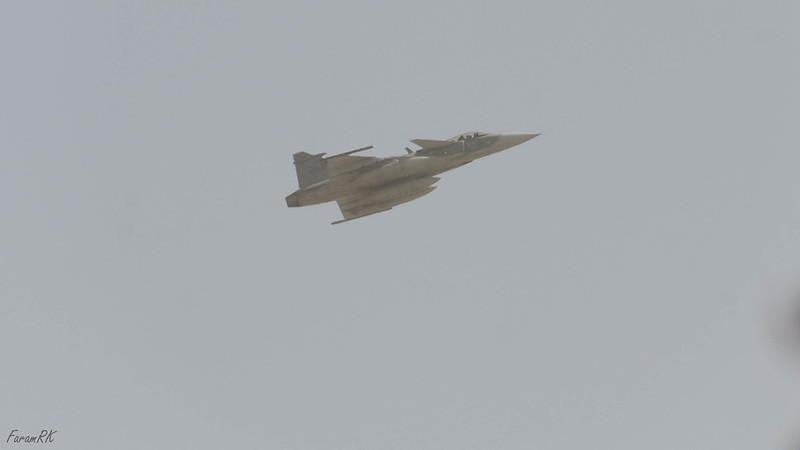Introduction
I attended Aero India 2017 on 18th February 2017. Having been bitten by the Ultralight philosophy, this time around I decided to shoot the whole airshow with a relatively small fixed-lens camera and a minimum number of accessories. Enter the Sony RX10 III 1" sensor superzoom bridge camera.
The Gear
I bought the Sony RX10 III a month before the airshow. This is a superzoom bridge camera with a 1 inch, 20 MP, 2.7x crop sensor.
The camera's standout feature is its bright 8.8mm - 220mm f/2.4 - f/4 lens which has a 35mm equivalent field of view of 24mm - 600mm. The lens is sharp wide open through out its zoom range. This is a very desirable attribute because its best to shoot this camera at or near base ISO, due to its relatively small sensor. The lens can be stopped down to f/16 but it's not advisable to shoot at f/8 or narrower, due to diffraction effects.
I started practising in earnest on BIFs (Birds In Flight) at the local bird sanctuary.
As expected, for fast moving subjects, the Contrast Detect Autofocus performance wasn't at par with even an entry level DSLR. And the EVF (Electronic Viewfinder) didn't make it easier to track fast moving and erratic BIF, due to its slight lag and 'slideshow' effect. Anyway, the whole idea of the weekend hours long practice sessions was to try out various settings of the camera, especially different combinations of autofocus modes and shooting techniques, to workaround limitations of the camera and get the maximum chance of success when tracking fast moving subjects. My notes on camera impressions and settings for the Sony RX10 III are here - https://goo.gl/ggec3Q.
On the topic of EVFs, this camera has a superb large and bright viewfinder, a world apart from the dingy, streaky EVFs I had seen in smaller bridge cameras of a few years ago (2009 - 2011).
In order to mitigate the effects of tracking a fast moving subject through the narrow field of view of a 600mm equivalent lens and an EVF, I had ordered a Reflex (aka Red Dot) Sight to attach to the hotshoe of the camera. This would allow easier tracking of a fast moving subject by allowing both eyes to be open with its benefit of vast field of view and peripheral vision. The disadvantage of this technique was that there was no way to check framing of the subject in the frame, so for larger subjects, one needed to set the zoom beforehand, based on an educated guess. This device arrived a few hours before I was to depart on my flight to the airshow, so I spent the time productively by mounting it on the camera and tracking wheeling black kites over my home. It was a revelation to be able to track BIFs out of the narrow confines of looking through a viewfinder and long lens.
My photography/videography kit consisted of -
- Sony RX10 III bridge camera.
- Tiffen 72mm Variable Neutral Density Filter (for shooting helicopters and propeller aircraft at relatively slow shutter speeds with lens wide open, under bright sunlight).
- Olympus EE-1 Red Dot Sight.
- Xume 72mm magnetic quick release adapters for the VND filter (to allow quick switching between shooting fighter jets and propeller/rotor aircraft).
- Extra Batteries - 3x Sony NP-FW50 batteries.
- 1x 64 GB SD Card in camera.
- Extra SD Cards - 2x 64 GB.
- Battery Charger.
- Lens cleaning cloth.
Total kit weight: 1.5 kg (3.3 lb).

I did not take my tried and trusted DSLR kit with me. This ensured that I didn't chicken out at the last minute and shoot with the DSLR instead of the bridge camera :)
The Show
As always, the show was held at Air Force Station Yelahanka, Bangalore (aka Bengaluru), India. I stayed in a small hotel, 4 KM south of the venue.
I had an early breakfast and left the hotel at 0730. Considering the long traffic jams the last time around, I thought I would walk to the show this time, but in the end I decided to go in a hired car, even though the fellow charged nearly ten times the normal cab rate. Even at that early hour, we still got stuck in a traffic jam on the road outside the airbase. The arrangements were chaotic as usual, with most of the policemen on duty having no clue on where to guide the spectators.
I had bought a 'General visitor Exhibition area' ticket online. The idea was to redeem a barcode printout of this ticket at one of the airshow gates, for a 'gate pass' that allowed one to enter the airbase. After much confusion, we finally made it inside Gate 5, which is on the eastern side of the road, opposite the threshold of RW27 of the airbase. There was a large tent inside which tickets were being exchanged for gate passes. There were about ten queues with 5-6 people at each queue. So I made made it through this step, relatively painlessly and fast. By 0820 I was waiting with pass in hand for one of the airshow buses. This bus dropped us at a spot opposite the main airshow entrance. Then there was a 900m walk to the exhibition halls. There were two security checks near the start and end of the walk. There were already long lines at the security checks, but the lines were processed very fast without any hassles. I arrived at the exhibition halls at 0840.
Being the last day of the airshow, and with all the business meetings done, most of the exhibition stands were empty and I went through the stands in ten minutes to arrive at the apron at 0850. After a whirlwind tour of the static display before the fence, consisting of the Saab Gripen (new for the 2017 edition), Dassault Rafale, HAL Tejas, and a few UAVs, I arrived near the fence at 0900, ready for the airshow proper to begin.



I could not get a place at the fence as it was already lined up with spectators. I did get a place at the eastern end of the fence by clambering up a small wall, but the narrow ledge didn't afford a stable platform to pan my camera, so I hopped down again.



I could not get a place at the fence as it was already lined up with spectators. I did get a place at the eastern end of the fence by clambering up a small wall, but the narrow ledge didn't afford a stable platform to pan my camera, so I hopped down again.
The air display was a treat, consisting of biplanes, wingwalkers, helicopters, transporters, trainers and fast jets. It ranged from solo displays to six ship formations.
There was an easterly breeze so all takeoffs and landings, except one by the Rafale, were from RW 09. The runway threshold was 1.4 KM from where I was located. Due to a dip in the land and the fact that there were a couple of rows of spectators in front of me, I was unable to take any good takeoff and landing photos except for a few aircraft landing in the heat-shimmered distance.
Photography & Videography
The camera behaved quite admirably, taking into account that it used Contrast Detect autofocus.
For the static displays and for most of the video shots, I have absolutely no complaints. And it is very liberating to be carrying a relatively small and light body with a fixed lens that zooms all the way from 25mm equivalent to 600mm equivalent, without the hassle of needing to change lenses in a crowded, hot and dusty environment.
But shooting fast moving aircraft wasn't fun. Even though I got a lot of good shots (as displayed in this post), there were also a lot of blurred and mis-focused shots, most of which would have been nailed by a mid level DSLR. As the bright sun rose higher in the sky and the contrast became less and the air became filled with smoke released by the aerobatic aircraft, it became quite difficult for the camera to focus on fast moving aircraft, especially the grey coloured fighter jets.
On the other hand, video shooting was quite pleasant. It was far easier, less tiring, and more enjoyable shooting video with a relatively light camera with a rocker zoom rather than a full frame DSLR with a long heavy lens. The autofocus worked most of the time, unlike a DSLR where manual focus with the lens stopped down for wide depth of field, would be the only viable option. Also, I shot the jets with a high shutter speed so each frame of the resultant videos were very crisp and worth transforming into 8 MP still images. I shot video at 4k 25p.
Here's a video of the event. Caution - jerky video, viewer discretion advised :) -
I shot in Raw format, AF-C, Continuous Drive (supposed to be 5 fps, but seemed slower due to slow AF between shots), AF Area Centre or Wide.
I shot the jets in Aperture priority with minimum shutters speeds of 1/1,000 to 1/4,000s. Due to the slidehow effect and slightly laggy nature of the EVF, a lot of times, I needed to shoot at 1/4,000s and had to use the EE-1 RDS. I'm not sure why, but there were many images, even at 1/4,000s which were blurred. Due to shooting at 1/4,000s, the ISO went up to 640 - 800 which caused a large increase in image noise. Also, one thing I noted while reviewing the images was that even at 1/4,000s the images didn't have the crisp details one would have expected. This isn't a problem with the sensor because the camera created crisp detailed images of the static displays. Could this be due to minute rolling shutter effect or some other effect of the electronic shutter used by the camera at speeds faster than 1/1,000s ?
For helicopters and propeller aircraft, I used Shutter priority with speeds ranging from 1/100s to 1/320s. I set the VND filter such that aperture was at or near wide open.
One thing to be careful about when shooting with an RDS is that there is no subject framing information. One could briefly look at the rear LCD to check framing, but in the heat of the moment of an aircraft pass, I could never remember to do so. This resulted in many aircraft with parts cut off :)
It might be a good idea to reduce the lens zoom to wider than usual, when shooting with an RDS.
So, would I recommend using the Sony RX10 III instead of a DSLR with a long telephoto lens, for shooting an airshow ? No. Though it is an excellent versatile camera with an excellent lens, a great EVF and really good image quality at and near base ISO, its autofocus performance cannot (mostly) keep up with the fast action demands of an airshow.
One, not insignificant, advantage of this camera over a DSLR with long lens, is negligible joints and muscle fatigue, even after a full day's shooting.
Statistics
Batteries used: Nearly 3.
Images shot: 2,042 (36 GB)
Videos shot: 86, 28' 14", 22 GB.
Keepers: 204 images.
Other Stuff
As the day progressed, it became very hot, and soon after arriving, the wide brimmed hat and sunglasses had to be brought out, in addition to rolling down the sleeves. The hot tarmac was also reflecting the heat, but there was no place to sit other than on it :)

I carried two 1 Litre water bottles, in addition to which I also drank a fruit juice from one of the fast food stands. There is always a danger of dehydration and sunstroke due to the heat. Also, this time, there seemed to be even more people packed into the same area as four years ago, which made the atmosphere even more oppressive. There was barely room to pan around with a camera. But I was better off than the poor sods packed into the concentration camp (aka ADVA aka Air Display Viewing Area) near the threshold of RW09. I had mistakenly booked a (cheaper) ticket for that area in 2015, but I didn't make that same mistake again :) On the plus side, the ADVA inmates got a far better view of the landing and takeoff action.
When hundreds of thousands of people attend the airshow on each of the days it runs, it's only fair and sensible that the organizers allow the whole length of the runway, south of the taxiways and apron, to be used as a viewing area rather than the two measly enclosures at the runway threshold and centre. And there needs to be a better way to procure tickets and use them at the show rather than this rigmarole of buying a ticket online then receiving an email with a barcode (which many people didn't receive, causing classic confrontations with mulish officials at the gates), taking a printout of the barcode and handing it over at one gate, getting a gate pass and using it to enter through another gate...Was the person who designed this devilish scheme a strait-jacketed inmate of a mental asylum ?!
In the past, I used to stick around until after 1700 when the show definitely came to an end. But this time around, due to the larger rush of people, we decided to call it a day at 1630, by which time a section of the crowd had already started streaming out, so there was a huge traffic jam by the time we made it out of the gates.
Conclusion
While departing Bangalore, I got a few pleasant sunset shots with my ever handy camera phone. Though I always have a hankering for a 'one tool does it all' i.e. DSLR performance and image quality in a phone size form factor, the reality is, as always 'use the right tool for the job' i.e. a DSLR and long lens for an airshow, a camera phone for window seat shooting and a 1" sensor compact/bridge camera for everything in between :)
On a final note, two days after I reached home, I heard a loud fighter jet roar and rushed to my window with a D7000 mounted with an 18-300mm lens (a bit short for a shooting a small fighter jet a km away), which I had taken out for some airing. I managed to get a few shots of a couple of Gripens flashing by. They were returning to their home base from the Aero India show and transiting VAAH (for a pit stop I presume). By a remarkable coincidence, one of them (No. 262) was the same one which I had photographed at the airshow two days ago. Bon voyage and happy landings my friend, and see you again in 2019 !
Other Links
Flickr album of the event - https://flic.kr/s/aHskRGVUrm
Sony RX10 III notes - https://goo.gl/ggec3Q


















Thanks Faram,
ReplyDeleteI am not sure what a Bridge Camera is but it might be similar to my Panasonic DMC-FZ300. Much more than I need at present.
Thanks for the story and the Airshow Photos. I attended the Avalon (Australia Vic) Airshow a month ago and saw some of these aircraft. I did not see a SAAB Grippen. The SAAB Grippen has been promoted by David Archibald as the best overall replacement fighter (better than the F35).
Yours Peter Champness
Good to hear from you Peter.
DeleteA Bridge camera bridges the gap between a compact camera and a DSLR. It usually has a sensor size of 1/2.3" to 1" and a superzoom lens. Your FZ300 is a bridge camera.
I saw the Gripen in real life for the first time at this airshow and it is impressive. They were also allowing people to sit in the cockpit but I gave it a miss as there was a long queue, and the airshow proper was about to start.
Cheers